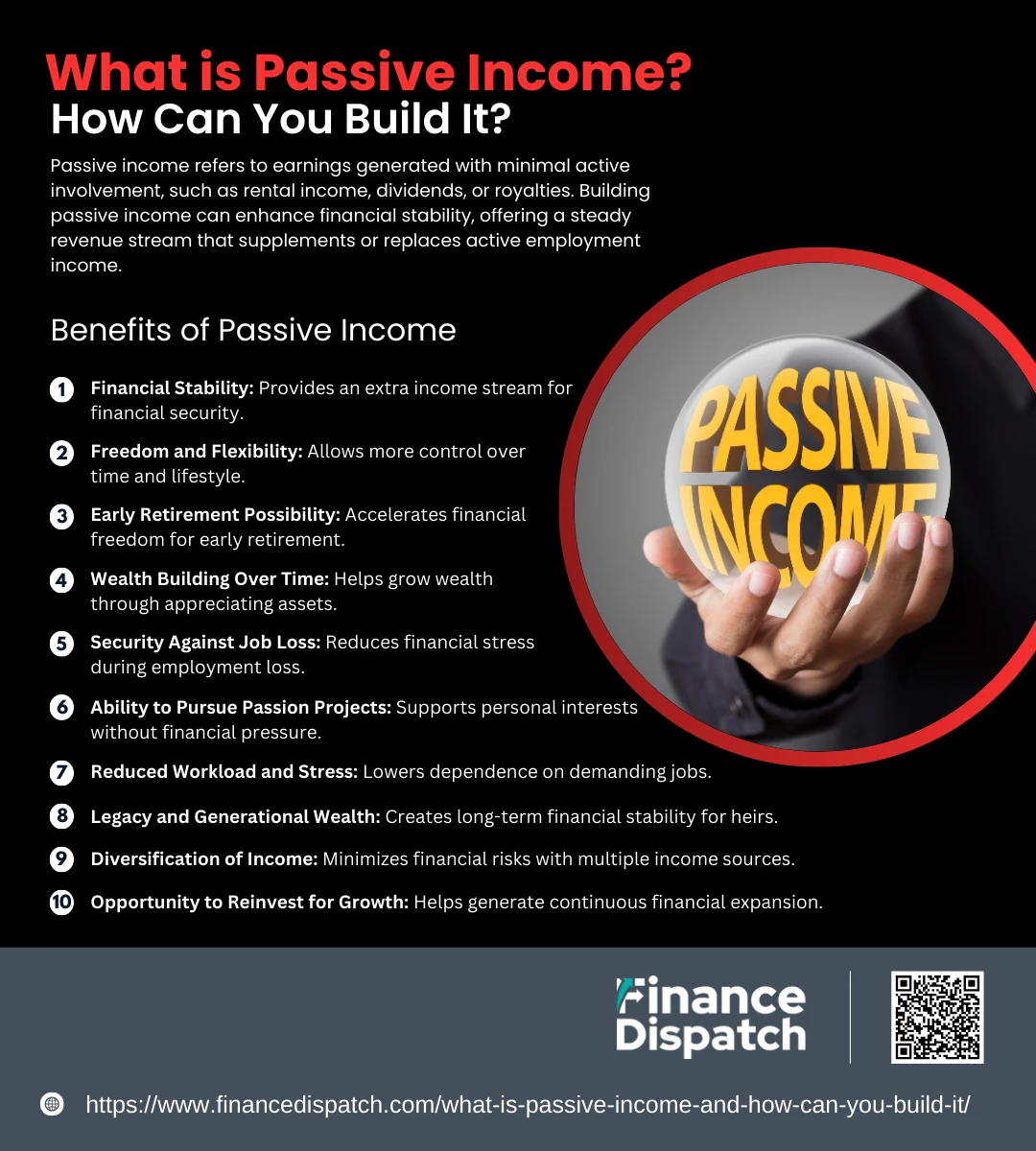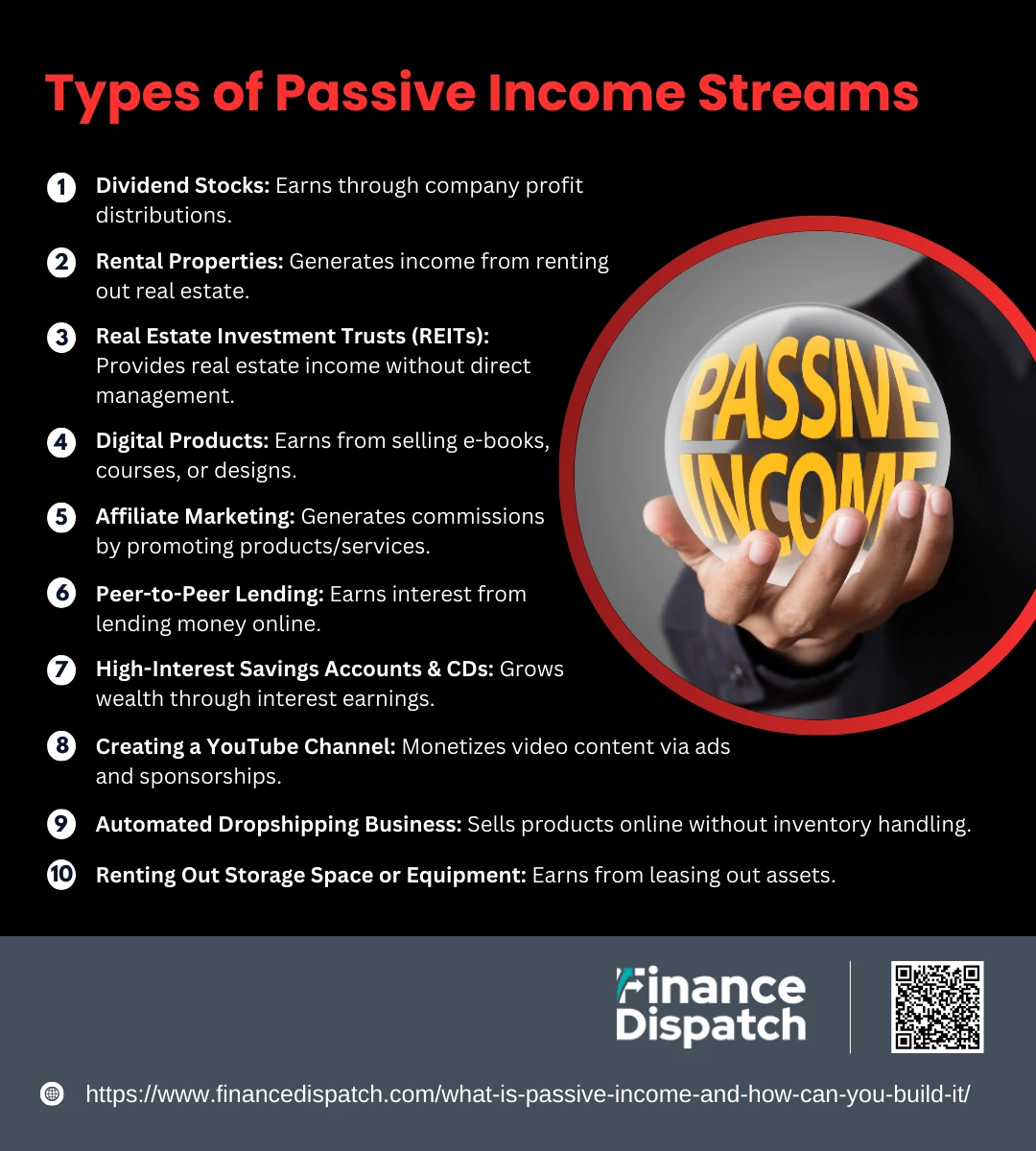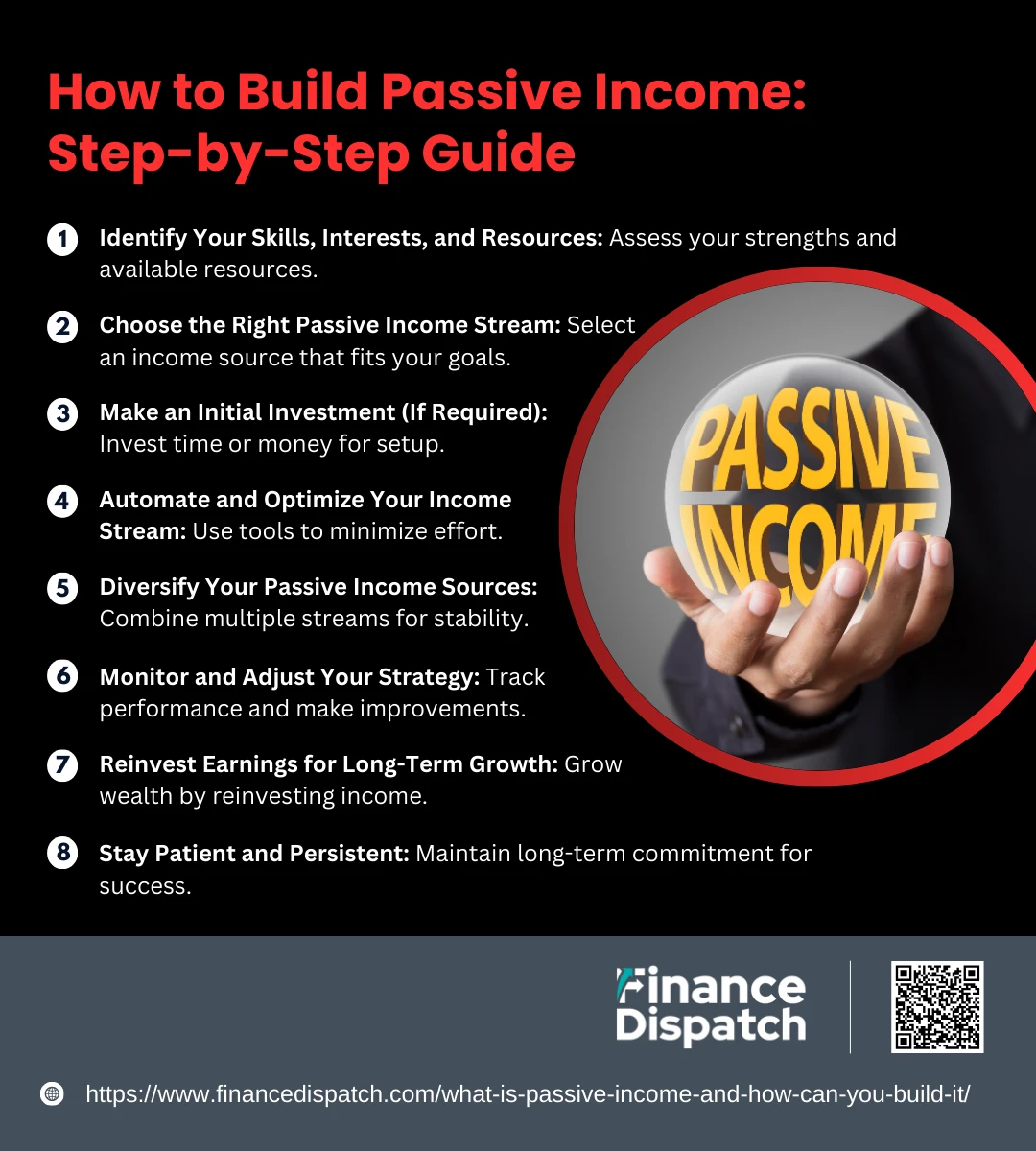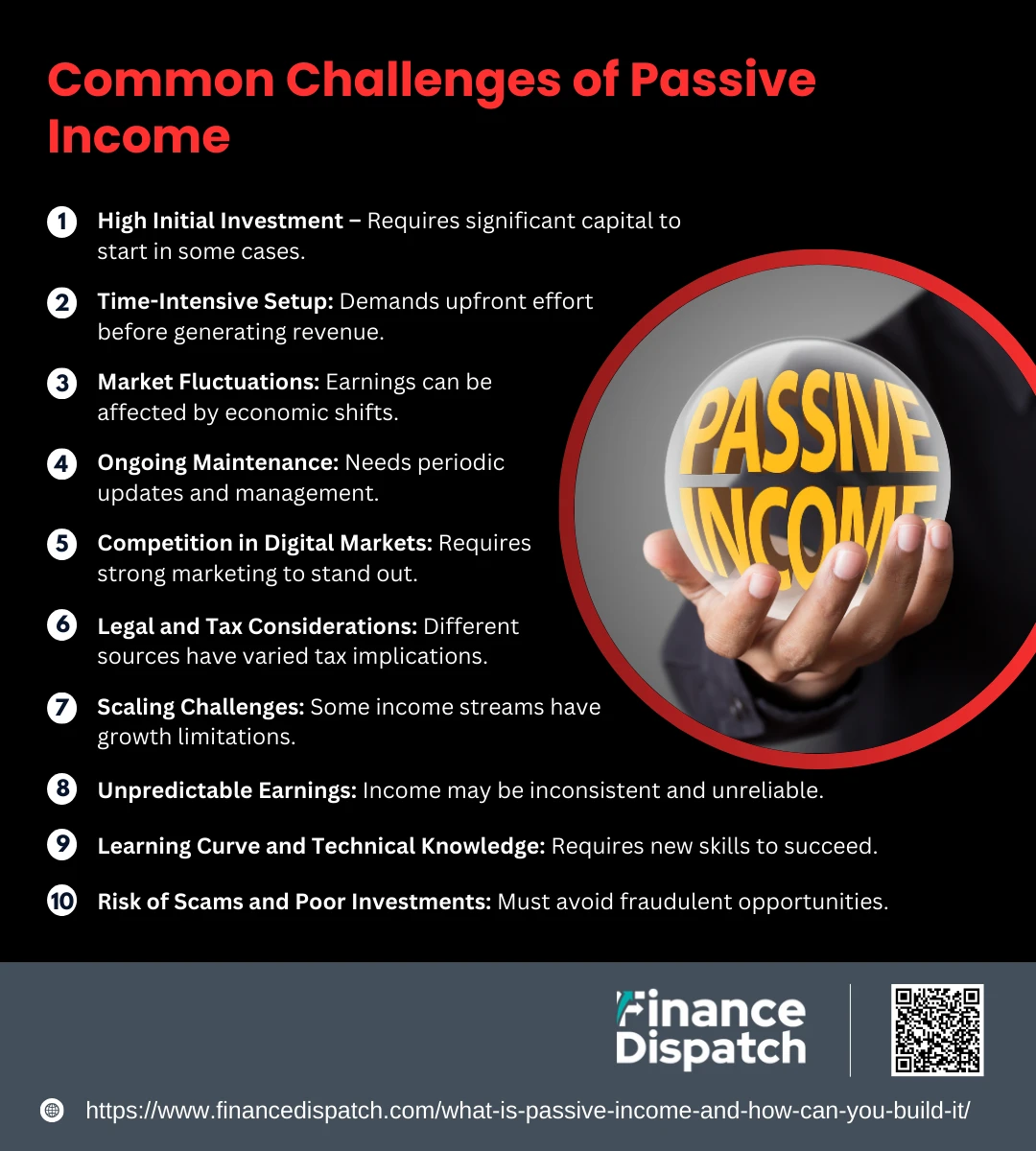Imagine earning money even while you sleep. That’s the power of passive income—a financial strategy that allows you to generate earnings with little to no ongoing effort. Unlike traditional jobs where income is directly tied to hours worked, passive income provides financial stability by leveraging assets, investments, or digital platforms to create a continuous revenue stream. Whether it’s dividends from stocks, rental income, or online ventures, passive income can help you achieve financial freedom, reduce dependency on a paycheck, and even retire early. However, building passive income isn’t a get-rich-quick scheme—it requires initial effort, smart planning, and patience. In this article, we’ll explore what passive income is, why it matters, and how you can start building your own passive income streams today.
What is Passive Income?
Passive income is money earned with little to no ongoing effort after an initial investment of time, money, or resources. Unlike active income, which requires continuous work—such as a salary or hourly wage—passive income allows you to generate earnings without being directly involved in daily operations. It can come from various sources, including rental properties, dividend stocks, digital products, or automated businesses. While some passive income streams require significant effort upfront, such as creating an online course or purchasing real estate, they can eventually provide steady financial returns with minimal maintenance. The key to building passive income is finding scalable and sustainable methods that align with your skills and financial goals, allowing you to achieve greater financial independence over time.
 Benefits of Passive Income
Benefits of Passive Income
Passive income is a powerful financial strategy that allows you to earn money without being actively involved in day-to-day work. Unlike traditional jobs that require continuous effort in exchange for a paycheck, passive income streams generate revenue with minimal maintenance after an initial investment of time, money, or effort. Whether it’s through investments, real estate, digital products, or business automation, passive income can provide financial security, greater flexibility, and long-term wealth. Below are some of the key benefits of building passive income:
1. Financial Stability
Relying on a single paycheck can be risky, especially during economic downturns or unexpected job loss. Passive income provides an additional revenue stream, ensuring that you have financial security even if your primary source of income is disrupted.
2. Freedom and Flexibility
With passive income, you are no longer tied to a strict work schedule. This allows you to spend more time with your family, travel, or focus on personal projects without worrying about your financial well-being.
3. Early Retirement Possibility
Most people rely on their jobs to save for retirement, but passive income can accelerate this process. With a steady stream of earnings from investments, rental properties, or digital assets, you may be able to retire earlier and enjoy financial freedom sooner than expected.
4. Wealth Building Over Time
Many passive income sources, such as real estate and dividend stocks, grow in value over time. As your investments appreciate and generate returns, your wealth continues to increase, allowing you to achieve long-term financial success.
5. Security Against Job Loss
Losing a job can be financially devastating, but having passive income reduces the stress of such situations. If you have multiple income streams, you are better prepared to handle financial emergencies without disrupting your lifestyle.
6. Ability to Pursue Passion Projects
Having a reliable passive income allows you to explore personal passions, whether it’s starting a new business, creating art, or volunteering. You are not bound by the need to work solely for financial survival, giving you the freedom to pursue what truly matters to you.
7. Reduced Workload and Stress
A traditional job often comes with long hours and high levels of stress. Passive income enables you to step back from a demanding workload while still earning money, improving your work-life balance and overall well-being.
8. Legacy and Generational Wealth
Passive income sources like rental properties, investments, and digital products can be passed down to future generations. This helps secure financial stability for your family and creates a lasting legacy of wealth.
9. Diversification of Income
Relying on one source of income is risky, especially during economic uncertainty. By diversifying your earnings through multiple passive income streams, you minimize financial risks and create a more resilient financial future.
10. Opportunity to Reinvest for Growth
Extra income from passive sources can be reinvested into other opportunities, such as new investments, expanding businesses, or purchasing more income-generating assets. This creates a cycle of continuous financial growth and wealth accumulation.
 Types of Passive Income Streams
Types of Passive Income Streams
Passive income can be generated in various ways, depending on your interests, skills, and financial resources. While some streams require an initial monetary investment, others demand more time and effort upfront before they start yielding consistent returns. The key to building a sustainable passive income is to choose methods that align with your long-term financial goals. Below are some of the most common types of passive income streams:
1. Dividend Stocks
Investing in dividend-paying stocks allows you to earn passive income through regular payouts from company profits. Many established companies distribute a portion of their earnings to shareholders, making it a reliable source of income for long-term investors.
2. Rental Properties
Owning and renting out real estate is one of the most well-known passive income sources. Whether it’s residential or commercial property, rental income can provide a steady cash flow, though it requires initial investment and ongoing property management.
3. Real Estate Investment Trusts (REITs)
For those who want to invest in real estate without the responsibilities of managing properties, REITs offer an alternative. These are companies that own and operate income-generating properties, and they pay dividends to investors.
4. Digital Products
Selling digital products such as e-books, printables, stock photos, or online courses can generate passive income once created. Platforms like Amazon Kindle Direct Publishing, Etsy, and Udemy make it easy to sell digital goods to a global audience.
5. Affiliate Marketing
By promoting products or services through an affiliate program, you can earn commissions on sales made through your referral links. This method is popular among bloggers, influencers, and website owners who monetize their content.
6. Peer-to-Peer Lending
Online lending platforms allow you to loan money to individuals or small businesses in exchange for interest payments. While this method carries some risk, it can provide a high return on investment when properly managed.
7. High-Interest Savings Accounts & CDs
Keeping your money in high-yield savings accounts or certificates of deposit (CDs) allows you to earn passive income through interest. While not the most lucrative option, it’s a low-risk way to grow your wealth over time.
8. Creating a YouTube Channel
If you have expertise or entertainment value to share, starting a YouTube channel can be a great passive income source. Once you gain enough subscribers and watch hours, you can monetize through ads, sponsorships, and memberships.
9. Automated Dropshipping Business
Dropshipping allows you to sell products online without handling inventory. Once the business is set up and automated, customer orders are fulfilled directly by suppliers, allowing you to earn passive income with minimal involvement.
10. Renting Out Storage Space or Equipment
If you have unused storage space, a car, tools, or equipment, you can rent them out to people who need them. Platforms like Airbnb for extra rooms or peer-to-peer rental services for tools make it easy to monetize underutilized assets.
 How to Build Passive Income: Step-by-Step Guide
How to Build Passive Income: Step-by-Step Guide
Building passive income is one of the most effective ways to achieve financial freedom. Unlike active income, which requires continuous work, passive income allows you to earn money with minimal ongoing effort once the initial setup is complete. While it may take time, planning, and sometimes investment, the long-term benefits can provide financial stability, freedom, and even early retirement. Below is a step-by-step guide to help you start building sustainable passive income streams.
1. Identify Your Skills, Interests, and Resources
Before choosing a passive income stream, assess what you have to offer. Consider your skills, financial resources, and the amount of time you can dedicate to setting up your income stream.
2. Choose the Right Passive Income Stream
There are various types of passive income sources, such as investing in dividend stocks, renting out real estate, selling digital products, or creating an automated business. Select an option that aligns with your financial goals and capabilities.
3. Make an Initial Investment (If Required)
Many passive income ideas require upfront investment—whether it’s money (e.g., real estate, stock market) or time (e.g., creating an online course, writing an e-book). Be prepared to invest in the right resources to set up your income stream effectively.
4. Automate and Optimize Your Income Stream
Passive income should require minimal effort after the initial setup. Use automation tools to streamline processes—such as scheduling content, setting up recurring investments, or automating order fulfillment for e-commerce businesses.
5. Diversify Your Passive Income Sources
Relying on just one passive income source can be risky. Consider diversifying by combining multiple streams, such as investing in dividend stocks while renting out property or selling digital products.
6. Monitor and Adjust Your Strategy
Even passive income requires occasional monitoring. Track your progress, make necessary adjustments, and optimize your strategies to ensure consistent earnings and growth.
7. Reinvest Earnings for Long-Term Growth
Instead of spending all your passive income, reinvest a portion of it to create more income-generating assets. This can help accelerate wealth accumulation and financial independence.
8. Stay Patient and Persistent
Building passive income takes time and effort before you see significant results. Stay committed, continuously learn from your experiences, and adapt your strategy as needed.
How Much Can You Earn from Passive Income?
The amount you can earn from passive income depends on several factors, including the type of income stream, your initial investment, and the time you dedicate to setting it up. Some passive income sources, like dividend stocks or high-yield savings accounts, may generate a few hundred dollars per year, while others, such as rental properties or digital businesses, can bring in thousands of dollars each month. For example, a well-performing real estate rental could generate $1,000–$3,000 per month, while a successful online course or e-book might earn anywhere from a few dollars to six figures annually. While passive income doesn’t guarantee overnight wealth, consistent effort and smart financial decisions can lead to long-term financial stability and even early retirement. The key is to diversify your income sources and reinvest earnings to maximize your potential profits over time.
 Common Challenges of Passive Income
Common Challenges of Passive Income
While passive income offers financial freedom and long-term wealth-building opportunities, it is not entirely effortless. Many people assume that once a passive income stream is set up, it will generate money indefinitely without any further effort. However, most passive income sources require an initial investment of time, money, or both, and some even need ongoing maintenance. From high upfront costs to market fluctuations, there are several challenges that can make passive income more complex than it seems. Below are some common obstacles you might face when building passive income and how to manage them effectively.
1. High Initial Investment
Some passive income sources, like rental properties or dividend stocks, require significant upfront capital. Without enough savings or funding, it may take longer to establish a profitable income stream.
2. Time-Intensive Setup
Certain income streams, such as creating an online course, writing an e-book, or building a blog, require a lot of work before they start generating revenue. Many people give up too soon because they underestimate the initial effort involved.
3. Market Fluctuations
Investments, including stocks, real estate, and cryptocurrency, are subject to market risks. Economic downturns, inflation, or industry shifts can impact earnings and even lead to losses.
4. Ongoing Maintenance
Despite being “passive,” many income streams still require periodic attention. Rental properties need upkeep, digital businesses require updates, and affiliate marketing depends on consistent content creation to maintain revenue.
5. Competition in Digital Markets
Selling e-books, online courses, or print-on-demand products can be profitable, but competition is fierce. Standing out requires strong marketing strategies, high-quality content, and ongoing optimization.
6. Legal and Tax Considerations
Different passive income sources have various tax implications. Rental income, dividends, and business earnings may be taxed differently, requiring proper financial planning and sometimes legal assistance.
7. Scaling Challenges
Some passive income sources have limits to scalability. For example, a rental property portfolio requires significant capital to expand, while content-based income sources like blogging or YouTube need continuous engagement to grow.
8. Unpredictable Earnings
Unlike a fixed salary, passive income can be inconsistent. Digital product sales, ad revenue, or stock dividends may fluctuate, making it difficult to rely solely on passive income for financial stability.
9. Learning Curve and Technical Knowledge
Building passive income streams often requires new skills, such as financial investing, online marketing, SEO, or content creation. Without the right knowledge, it can take longer to achieve success.
10. Risk of Scams and Poor Investments
With the growing interest in passive income, many fraudulent schemes promise “quick and easy” money. Being cautious and conducting thorough research before investing time or money into a venture is essential to avoid losses.
Risks and How to Mitigate Them
Every financial opportunity, including passive income, comes with risks. While passive income can provide financial stability and long-term wealth, it is not without challenges such as market fluctuations, financial losses, and legal implications. Understanding these risks is crucial to making informed decisions and protecting your investments. Fortunately, there are strategies to mitigate these risks and ensure your passive income streams remain stable and profitable. Below are some common risks associated with passive income and ways to manage them effectively.
Common Risks and How to Mitigate Them:
- High Initial Investment Risk – Some passive income sources, like real estate and stock investments, require significant upfront capital.
Mitigation: Start with smaller, low-cost investments, such as dividend stocks or digital products, before scaling up. - Market Volatility – Investments like stocks, cryptocurrency, and real estate are subject to economic downturns and market fluctuations.
Mitigation: Diversify your portfolio to reduce risk exposure and focus on long-term investment strategies rather than short-term gains. - Unpredictable Earnings – Income from digital products, affiliate marketing, or rental properties can fluctuate depending on demand and external factors.
Mitigation: Have multiple passive income streams to create a more stable revenue flow and build an emergency fund for financial security. - Legal and Tax Issues – Different income sources have unique tax requirements and legal obligations, which can lead to unexpected penalties.
Mitigation: Consult a financial advisor or tax expert to ensure compliance and proper tax planning for your income sources. - Ongoing Maintenance Costs – Rental properties, websites, and digital businesses may require regular maintenance, leading to additional expenses.
Mitigation: Factor in maintenance costs when budgeting and automate or outsource tasks where possible to reduce workload. - Competition in Digital Markets – Selling e-books, online courses, or other digital products means competing with thousands of similar offerings.
Mitigation: Focus on high-quality content, strong marketing strategies, and continuous updates to keep your products relevant and competitive. - Time and Effort Required for Setup – Many passive income streams require initial time investment before they become profitable.
Mitigation: Plan realistically, set long-term goals, and automate processes to reduce the manual workload over time. - Fraud and Scams – Many passive income opportunities, especially in online investing and cryptocurrency, are prone to scams.
Mitigation: Conduct thorough research before investing, verify sources, and avoid “get-rich-quick” schemes that seem too good to be true. - Scaling Challenges – Some passive income methods, like rental properties or businesses, require more capital and resources to expand.
Mitigation: Scale gradually, reinvest earnings into growth, and optimize current income streams before expanding further.
Best Practices for Growing Passive Income
Building passive income is not just about setting up an income stream—it requires smart strategies to ensure consistent growth and long-term success. The key to maximizing passive earnings lies in diversification, reinvestment, and continuous optimization. Start by choosing income streams that align with your skills and financial goals, whether it’s investing in dividend stocks, real estate, or digital products. Automating processes, such as scheduling content or reinvesting dividends, can enhance efficiency and minimize manual effort. Additionally, reinvesting a portion of your passive earnings back into your ventures—whether to scale an online business, acquire more rental properties, or grow an investment portfolio—helps accelerate wealth accumulation. Keeping up with market trends, adapting to changes, and continuously learning new strategies will also ensure steady growth. By focusing on long-term sustainability and regularly evaluating performance, you can turn passive income into a reliable source of financial security and freedom.
Conclusion
Passive income is a powerful financial tool that provides stability, flexibility, and long-term wealth when built strategically. While it requires initial effort, investment, and patience, the rewards can be substantial—offering financial freedom, security, and even the possibility of early retirement. By diversifying income streams, reinvesting earnings, and staying adaptable to market changes, individuals can maximize their passive income potential. However, it is essential to approach passive income with realistic expectations, mitigate risks, and continuously optimize strategies for growth. Whether through investments, digital ventures, or rental income, passive income can serve as a stepping stone toward financial independence, allowing you to enjoy more freedom and control over your future.



